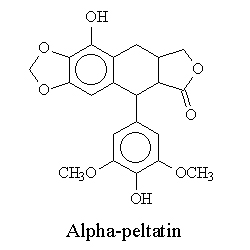
Hello, thank you for visiting this website. You will find information regarding the chemical structures of podophyllum lignans, and a brief history of this drug and its use.
Drug information
Podocon-25 is the brand name of 25% podophyllin in benzoin tincture. It is recommended for the treatment of anogenital warts (condyloma acuminata). More information on the current recommendations of this drug and other antivirals can be found on Thomas Chi's website.
Natural Sources
Podophyllum refers to a genus of plants. Both Podophyllum peltatum, a North American plant also known as May apple or Mandrake, and Podophyllum emodi, an Indian plant, are natural sources of podphyllin. Only the American plant is used for Podocon-25 preparation. The resin of P. peltatum contains four lignans, or active ingredients, which are chemically similar. Images of the may apple and lignans are below.






History
P. emodi and P. peltatum have been used by Native Americans and Indians for hundreds of years as emetics and antidotes for snake bites. In the 1940's podophyllin gained much acceptance in the medical community for treatment of genital warts. Since podophyllin stops cells in mitosis of metaphase and causes epithelial cell death, this drug was used to treat cancers of the skin, vulva and uterus. Unfortunately podophyllin offered few benefits and was discontinued as a cancer treatment.
Cellular Effects
Histological studies have revealed that podophyllin can enlarge cells and create a spongy appearance of the cytoplasm due to small granules of chromatin. Other cellular changes can make it difficult to distinguish squamous cell carcinoma from cells that have been treated with this drug.
Podophyllin and Pregnancy
Controversy exists over the use of podophyllin during pregnancy. Podophyllotoxin is a teratogen for mice, but it may be erroneous to assume similar effects in humans. There have been many reports of adverse effects in women that have used podophyllin, but Bargman explains how many of these reportings were incomplete in their reasoning for the lack of consideration of confounding factors. For example, the bleeding stomach of a woman was attributed to podophyllin use, but Bargman argues that her aspirin consumption could have produced this effect. He also cites a case study where pdodphyllin was attributed to the formation of a simian crease in a newborn. He considers this attribution erroneous since the treatment occured after the critical period for simian crease formation. Bargman concludes in his article that pregnancy should not contraindicate podophyllin usage with proper monitoring. The PDR recommends that pregnant women should not use podophyllum without studies on the safety of this drug.
Resources
Images of mayapple provided by Dr. Dan Brown of Cornell University.
Images of Podophyllum lignans were created with ChemWindow Version 5.0, and were based on information provided by the Merck index and article by Robert Miller.
References:
Miller, Robert. Podophllin International Journal of Dermatology October 1985 p 491-8.
Bargman, Howard. Is Podophyllin a Safe Drug to Use and Can It Be Used During Pregnancy? Archives of Dermatology November 1988, Volume 124, p 1718-20.
Comments? Email me.
Tell me more about viruses!
Last modified March 2, 2000
© 2000 Aaron Mansfield. All Rights Reserved.



